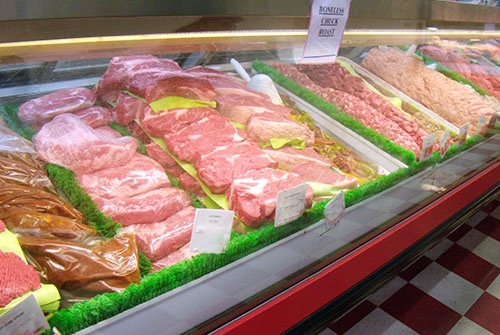Why Citizens Love Bagley Farms Meat Market Edwardsville IL for Their Meat Buying
Why Citizens Love Bagley Farms Meat Market Edwardsville IL for Their Meat Buying
Blog Article
Reveal the Art of the Butcher's Cut in a Modern Meat Market
In the ever-evolving landscape of modern-day meat markets, the butcher's cut has actually transcended its typical roots, combining age-old craftsmanship with modern practices. What absolutely sets the modern butcher apart is their capability to forge a deeper link between customers and the origins of their meat.
Advancement of Butchery Methods
The evolution of butchery techniques mirrors a rich tapestry of technology and adaptation driven by innovations in innovation, adjustments in consumer need, and a deeper understanding of meat scientific research. Historically, butchery was a craft passed down via generations, with methods refined over centuries to optimize yield and flavor. The commercial revolution ushered in mechanization, changing traditional practices and allowing large processing.
The mid-20th century saw butchery methods better refined by scientific understandings right into muscle biology and meat aging, enhancing both tenderness and taste. Technologies like vacuum packaging and refrigeration expanded item shelf-life, allowing butchers to diversify offerings and enhance high quality control. This duration additionally noted the surge of specialized equipment, such as band saws and meat slicers, which enhanced precision and effectiveness in meat handling.

The 21st century has actually presented digital innovation into the butchery realm. Electronic systems currently assist in monitoring pet provenance and maximizing cuts to fulfill certain client choices. Furthermore, a renewal in artisanal butchery has actually emerged, blending traditional skills with modern-day expertise to accommodate consumers seeking ethical and lasting meat alternatives. This advancement highlights a dynamic interplay in between practice and advancement, conference modern demands while maintaining the craft's heritage.
Recognizing Meat Cuts
Recognizing the complexities of meat cuts is crucial for both butchers and consumers looking for quality and value. For butchers, accurate cuts mirror skill and respect for the craft, making certain very little waste and optimum yield.

Understanding muscular tissue make-up is critical; muscle mass utilized more regularly by the animal tend to be harder and are best fit for slow food preparation techniques, while less-used muscle mass, like those found in the loin, are a lot more tender and suitable for cooking or roasting. Experience with these distinctions encourages consumers to make enlightened options, enhancing their cooking endeavors.
Choosing Quality Meat
Selecting the appropriate meat involves more than simply selecting a visually attractive item from the display. The my blog art of choosing quality meat needs a critical eye and expertise of specific qualities that indicate freshness and excellence.
Second of all, consider the marbling, which refers to the white streaks of fat within the muscular tissue. Proper marbling is an essential sign of inflammation and taste, as it thaws during cooking, improving the meat's juiciness. Bear in mind, greater marbling often correlates with premium high quality cuts, such as USDA Prime.
Structure is an additional crucial factor; meat needs to really feel firm to the touch, not slimy or excessively soft. Furthermore, be conscious of the aroma. Fresh meat ought to have a clean, neutral odor, complimentary from any kind of sour or repulsive smells.
Combining Cuts With Food Preparation Techniques

On the other hand, harder cuts like brisket and chuck roast are rich in collagen, which breaks down right into jelly when cooked slowly. These cuts are suitable for braising or slow-moving roasting, allowing the meat to tenderize over time and establish deep, complicated tastes. Similarly, cuts such as short ribs and pork shoulder get on well with slow-cooking techniques, where expanded cooking times change their durable structures right into delicious recipes.
Lamb shanks and oxtail, which need extended cooking to tenderize, are best prospects for cooking or slow-moving simmering. These approaches coax out rich, hearty flavors while maintaining moisture. By comprehending the distinct attributes of each cut, chefs and home cooks alike can raise their culinary developments, making sure each recipe is both pleasing and memorable.
The Butcher's Role Today
Navigating the advancing landscape of the modern-day meat market, the butcher's duty today extends past mere prep work of cuts. Contemporary butchers are cooking artisans, instructors, and advocates for lasting practices.
In enhancement to crafting exact cuts, butchers now engage straight with customers, using cooking advice and customizing options to fit specific requirements and preferences. Their experience in meat aging, marbling, and flavor accounts encourages consumers to make educated choices, enhancing their culinary experiences. This tailored service exhibits the butcher's developing function as a relied on expert in the kitchen.
Additionally, butchers are crucial in minimizing waste, using whole pets to develop varied products such as sausages and stocks. This detailed strategy not just respects the animal however likewise straightens with modern sustainability goals. In this means, the modern-day butcher embodies both tradition and development, adjusting to an ever-changing market while maintaining the artistry and stability of their craft.
Conclusion
The modern butcher's craft delicately weaves typical techniques with modern developments, highlighting sustainable methods and honest sourcing. Proficiency in comprehending varied meat cuts and high quality signs equips butchers to supply educated suggestions, lining up specific cuts with optimal cooking approaches. This proficiency not only boosts cooking experiences yet likewise enhances the connection in a knockout post between customers and the origins of their food. By honoring historical techniques while welcoming contemporary demands, the butcher's role continues to be essential in today's sophisticated meat market (bagley farms meat market edwardsville il).
Report this page